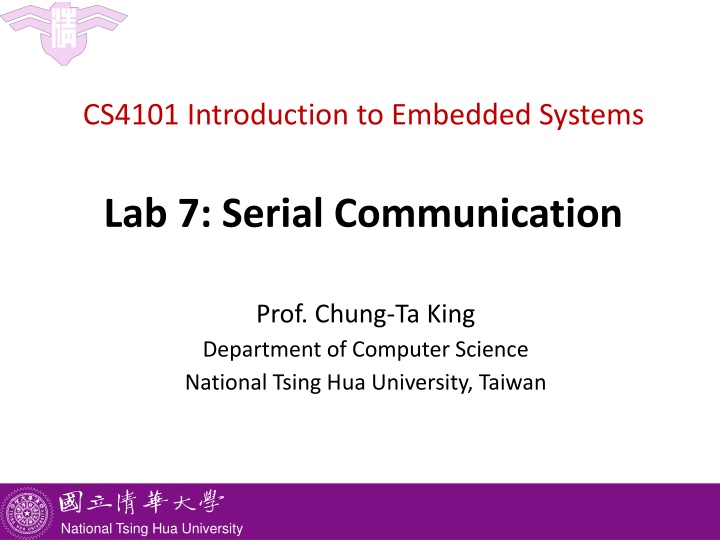
Learn Embedded Systems Lab Techniques for Serial Communication
Dive into the world of embedded systems with this lab focused on serial communication using MSP430 LaunchPad. Explore communication peripherals, software UART implementation, and RS232 interface communication between the LaunchPad and PC. Discover pin connections, transmission and reception strategies, and software UART operation with Timer_A.
Download Presentation

Please find below an Image/Link to download the presentation.
The content on the website is provided AS IS for your information and personal use only. It may not be sold, licensed, or shared on other websites without obtaining consent from the author. If you encounter any issues during the download, it is possible that the publisher has removed the file from their server.
You are allowed to download the files provided on this website for personal or commercial use, subject to the condition that they are used lawfully. All files are the property of their respective owners.
The content on the website is provided AS IS for your information and personal use only. It may not be sold, licensed, or shared on other websites without obtaining consent from the author.
E N D
Presentation Transcript
CS4101 Introduction to Embedded Systems Lab 7: Serial Communication Prof. Chung-Ta King Department of Computer Science National Tsing Hua University, Taiwan National Tsing Hua University
Introduction In this lab, we will learn Communication peripherals of MSP430 LaunchPad Implementation of a software UART on MSP430 LaunchPad Communication between MSP430 LaunchPad and PC through RS232 interface 1 National Tsing Hua University
Recall Pins for Comm P1.1 P1.2 TXD RXD 2 National Tsing Hua University
Pin Connections Use TACCR0 TXD Use TACCR1 RXD #define TXD 0x02 // TXD on P1.1 (Timer0_A.OUT0) #define RXD 0x04 // RXD on P1.2 (Timer0_A.CCI1A) P1SEL |= TXD + RXD; // Enable TXD/RXD pins P1DIR = 0xFF & ~RXD; // Set pins to output P1OUT = 0x00; // Initialize all GPIO 3 National Tsing Hua University
For Transmission TXD pin For Receive Latch allows sampling at precise time, regardless of ISR latency RXD pin 4 National Tsing Hua University
Receive of Software UART by Timer_A Between transmissions, CCR1 waits in Capture mode for a falling edge on its input. When a falling edge is detected, TACCR1 captures the count in TAR and raises an interrupt. CCR1 is switched to Compare mode and TACCR1 is set to fire an interrupt after 1.5 of the bit period from now. The next interrupt occurs and SCCI contains the value of LSB. ISR saves it. Next compare event is set up to occur after a further bit period. The above procedure is repeated until all 8 bits of data have been received. 5 National Tsing Hua University
Transmission of Software UART Use Capture/Compare Block 0 (TACCR0) OUTMOD_0: OUT0 signal is defined by OUT bit OUTMOD_2: OUT0 signal is reset when the timer counts to TACCR0 Use OUTMOD_0 to send a 1, OUTMOD_2 for 0 OUT0 6 National Tsing Hua University
TACCTLx 7 National Tsing Hua University
TACCTLx (contd) 8 National Tsing Hua University
Sample Code (msp430g2xx3_ta_uart9600) Software UART, using Timer_A, 9600 baud, echo, full duplex, SMCLK at 1MHz Main loop readies UART to receive one character and waits in LPM3 with all activity interrupt driven. TACCR0 and TACCR1 may interrupt at any time and in an interleaved way TAR keeps an independent time reference, while CCR0 and CCR1 handle time intervals 9 National Tsing Hua University
Sample Code (msp430g2xx3_ta_uart9600) #include "msp430g2553.h #define UART_TXD 0x02 // TXD on P1.1 (Timer0_A.OUT0) #define UART_RXD 0x04 // RXD on P1.2 (Timer0_A.CCI1A) #define UART_TBIT_DIV_2 (1000000 / (9600 * 2)) #define UART_TBIT (1000000 / 9600) unsigned int txData; // UART internal TX variable unsigned char rxBuffer; // Received UART character void TimerA_UART_init(void); void TimerA_UART_tx(unsigned char byte); void TimerA_UART_print(char *string); 10 National Tsing Hua University
Sample Code (msp430g2xx3_ta_uart9600) void main(void) { WDTCTL = WDTPW + WDTHOLD; // Stop watchdog timer DCOCTL = 0x00; // Set DCOCLK to 1MHz BCSCTL1 = CALBC1_1MHZ; DCOCTL = CALDCO_1MHZ; P1OUT = 0x00; // Initialize all GPIO P1SEL = UART_TXD + UART_RXD; // Use TXD/RXD pins P1DIR = 0xFF & ~UART_RXD; // Set pins to output __enable_interrupt(); 11 National Tsing Hua University
Sample Code (msp430g2xx3_ta_uart9600) TimerA_UART_init(); // Start Timer_A UART TimerA_UART_print("G2xx3 TimerA UART\r\n"); TimerA_UART_print("READY.\r\n"); for (;;) { // Wait for incoming character __bis_SR_register(LPM0_bits); // Echo received character TimerA_UART_tx(rxBuffer); } } void TimerA_UART_print(char *string) { while (*string) TimerA_UART_tx(*string++); } Waken up by Timer_A1_ISR 12 National Tsing Hua University
Sample Code (msp430g2xx3_ta_uart9600) void TimerA_UART_init(void) { TACCTL0 = OUT; // Set TXD idle as '1' TACCTL1 = SCS + CM1 + CAP + CCIE; // CCIS1 = 0 // Set RXD: sync, neg edge, capture, interrupt TACTL = TASSEL_2 + MC_2; // SMCLK, continuous mode } void TimerA_UART_tx(unsigned char byte) { while (TACCTL0 & CCIE); // Ensure last char TX'd TACCR0 = TAR; // Current state of TA counter TACCR0 += UART_TBIT; // One bit time till first bit TACCTL0 = OUTMOD0 + CCIE; // Set TXD on EQU0, Int txData = byte; // Load global variable txData |= 0x100; // Add stop bit to TXData txData <<= 1; // Add start bit } 13 National Tsing Hua University
Sample Code (msp430g2xx3_ta_uart9600) #pragma vector = TIMER0_A0_VECTOR __interrupt void Timer_A0_ISR(void) { static unsigned char txBitCnt = 10; TACCR0 += UART_TBIT; // Set TACCR0 for next intrpt if (txBitCnt == 0) { // All bits TXed? TACCTL0 &= ~CCIE; // Yes, disable intrpt txBitCnt = 10; // Re-load bit counter } else { if (txData & 0x01) {// Check next bit to TX TACCTL0 &= ~OUTMOD2; // TX '1 using OUTMODE0 } else { TACCTL0 |= OUTMOD2;} // TX '0 txData >>= 1; txBitCnt--; } } 14 National Tsing Hua University
Sample Code (msp430g2xx3_ta_uart9600) #pragma vector = TIMER0_A1_VECTOR __interrupt void Timer_A1_ISR(void) { static unsigned char rxBitCnt = 8; static unsigned char rxData = 0; switch (__even_in_range(TA0IV, TA0IV_TAIFG)) { case TA0IV_TACCR1: // TACCR1 CCIFG - UART RX TACCR1 += UART_TBIT; // Set TACCR1 for next int if (TACCTL1 & CAP) { // On start bit edge TACCTL1 &= ~CAP; // Switch to compare mode TACCR1 += UART_TBIT_DIV_2; // To middle of D0 } else { // Get next data bit rxData >>= 1; 15 National Tsing Hua University
Sample Code (msp430g2xx3_ta_uart9600) if (TACCTL1 & SCCI) { // Get bit from latch rxData |= 0x80; } rxBitCnt--; if (rxBitCnt == 0) { // All bits RXed? rxBuffer = rxData; // Store in global rxBitCnt = 8; // Re-load bit counter TACCTL1 |= CAP; // Switch to capture __bic_SR_register_on_exit(LPM0_bits); // Clear LPM0 bits from 0(SR) } } break; } } Wake up main loop 16 National Tsing Hua University
System Interrupt Word Address Interrupt Source Interrupt Flag Priority Power-up/external reset/Watchdog Timer+/flash key viol./PC out-of-range NMI/Oscillator Fault/ Flash access viol. Timer1_A3 Timer1_A3 Comparator_A+ Watchdog Timer+ Timer0_A3 PORIFG RSTIFG WDTIFG KEYV NMIIFG/OFIFG/ ACCVIFG TA1CCR0 CCFIG TA1CCR1/2 CCFIG, TAIFG CAIFG WDTIFG TA0CCR0 CCIFG 31 Reset 0FFFEh (highest) Non-maskable 0FFFCh 30 maskable maskable maskable maskable maskable 0FFFAh 0FFF8h 0FFF6h 0FFF4h 0FFF2h 29 28 27 26 25 Timer0_A3 TA0CCR1/2 CCIFG, TAIFG maskable 0FFF0h 24 0FFEEh 0FFECh 0FFEAh 23 22 21 Three sources of interrupts cause the same interrupt vector. Which one(s) cause the interrupt? ADC10 ADC10IFG maskable 0FFE8h 20 P2IFG.0 to P2IFG.7 check TAIV register I/O Port P2 (8) maskable 0FFE6h 19 I/O Port P1 (8) P1IFG.0 to P1IFG.7 maskable 0FFE4h 18 0FFE2h 0FFE0h 0FFDEh 0FFCDh 17 16 17 Unused 15 - 0 National Tsing Hua University
TAIV (Timer_A Interrupt Vector) On an interrupt, TAIV contains a number indicating the highest priority enabled interrupt: TACCR1_CCIFG, TACCR2_CCIFG, TAIFG Any access of TAIV resets the highest pending interrupt flag. If another interrupt flag is set, another interrupt is immediately generated 18 National Tsing Hua University
Setting PC for Serial Communication In the Debug perspective of CCS IDE, click [View] -> [Other ] and, in the Show View window, click the + next to Terminal. Select Terminal below that and click OK. 19 National Tsing Hua University
Setting PC for Serial Communication A Terminal pane will appear on the screen. Click the Settings button in the Terminal pane and make the selections (set the serial communication setting) 20 National Tsing Hua University
Basic Lab Temperature Sensing System MSP430 reads temperature from ADC every second. If the temperature is higher than 737, then flash the red LED at 5 Hz and send a string Alarm! to PC every second. Otherwise flash the green LED at 1 Hz and send a string Normal to PC every second. Hint: Use Timer_A alternatively for timing 1 sec and UART 21 National Tsing Hua University
Bonus Modify the basic lab so that when MSP430 receives the character 0 , it stops temperature sensing. While MSP430 is not sensing temperature, if it receives the character R , it turns on the red LED; if it receives the character G , turns on the green LED; and if it receives other characters, no LED is on. When MSP430 receives the character 1 , it goes back to basic lab. Use 4800 baud, 8-bit of data, and 2 stop bits. 22 National Tsing Hua University






